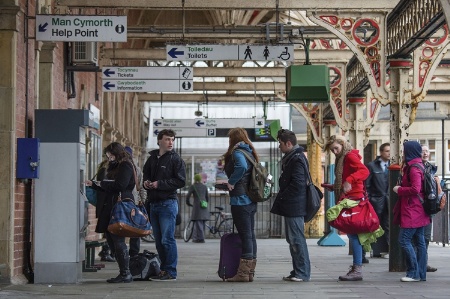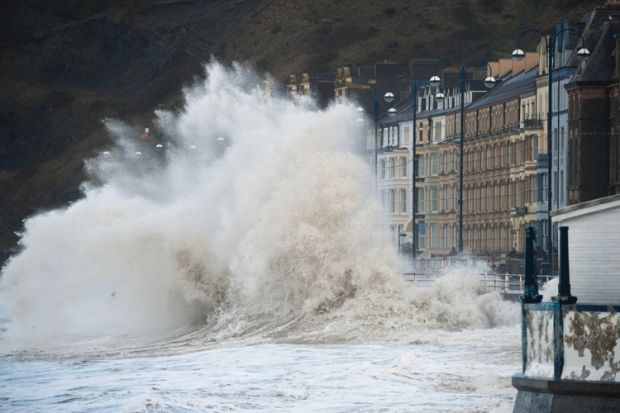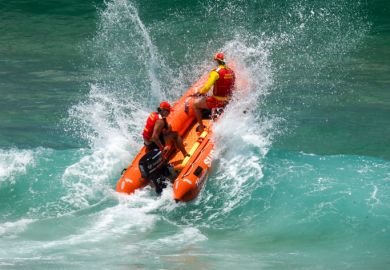Source: Alamy
“It’s a January day, and the weather is really foul. We are aware there’s a storm coming, and the spring tide is due, but there are no alerts in place to suggest anything other than a spectacular storm – and we get them all the time.”
When John Grattan, pro vice-chancellor for student experience at Aberystwyth University, recalls the build-up to the early January storms that forced his institution to evacuate hundreds of students from seafront accommodation, it sounds more like the start of a disaster movie than a simple logistics operation.
“At 5.30pm we get a call from porters at our seafront residence saying there are guys from the council there trying to put leaflets under the doors of all the rooms to tell them they need to evacuate.”
The university snapped into action. As Professor Grattan points out, the requirements of a local council when a storm is brewing are rather different from those of a university whose students are paying thousands of pounds a year – and might expect more than a leaflet under their door.
“The council’s need was to get them out; ours was to give our students a good experience,” he says. “Turfing them out on to the streets of Aberystwyth at eight in the evening is not good enough for us.”
As it was the first week of January most students were still away for the Christmas break, but there were still about 150 students to be relocated. Emails were sent out to all the students living in the affected area, asking them to assemble in the foyer of the seafront accommodation building at 7pm that evening. The high spring tide (a particularly high tide that coincides with a new or full moon) was due at 8.30pm, by which time students would have to be off the site.
To ensure that they were taken seriously, university representatives set off the building’s fire alarm to make sure all the inhabitants came to the meeting. They were then told they would be taken to the university’s main campus, which is at a safe height above sea level. Professor Grattan even manned a university minibus to help speed up the evacuation.
“Our reputation is built on student experience and everyone who was working at the time really got it,” he says. “We were all working very hard, staying late, preparing food for everyone who had been evacuated, all pulling together.”
Spur to prepare
Professor Grattan admits that, on this occasion, the university was to an extent “making it up as [it] went along”. The incident, which lasted several days, highlighted a need to shore up its lines of communication with a number of other organisations including the local council, the fire service and Natural Resources Wales, which advises the Welsh government on environmental issues.
“We realised that we needed to do things better. The key was to identify the decisions we needed to make and at what time, and communicate this chain of events to students, so that they would know what was happening.”
The university put this “plan of action” up on its website, so that students would know exactly what steps would be taken in the event of a recurrence. They did not have to wait long. A few weeks later, in late January, an unusually high tide was due and the weather forecast was not good. This time the university was better prepared.

“A storm was forecast for the start of our examination period, and if students had returned as planned and the weather had been as bad as it had been the first time, we would have gone from evacuating more than 150 students to evacuating beyond 800, maybe up to 1,000,” Professor Grattan recalls.
“We postponed examinations for a week, which was the biggest decision of my career, but I made it in about five minutes because it was clear to me that we had to do it.”
The university also cancelled lectures, and even paid the train and bus fares of students who had already returned to the town and would now need to go back home. About 300 students who could not return home, including those from overseas, were found alternative accommodation away from the at-risk areas.
“We had a choice about whether this was an event that we could manage, or something that could escalate into a crisis,” Professor Grattan says. “We decided to make it into a managed event.”
Acknowledging that not all students use email accounts, the university adopted a broader approach to communicating with students, sending out updates on its Twitter and Facebook accounts, and updating its website regularly.
One of the most successful tactics involved regularly filming updates – presented by Rebecca Davies, pro vice-chancellor for student and staff services – and uploading them to the video-sharing website YouTube and linking them to the university’s other online channels.
“We recorded a video update every couple of hours,” Professor Grattan says. “Because the decision-making structure was now laid out on our website, we knew exactly what to tell the students. We could let them know when we would be making decisions, what the choices were and where they could find out what was going to happen.”
The video messages were viewed more than 10,000 times, and the university also noticed an increase in the number of tweets being retweeted by students who were using Twitter to help keep their friends informed about the situation.
The university is now taking further steps to ensure that future storm warnings are acted on in the best possible way. This involves working more closely with the council to map at-risk areas of the town against the addresses of all their students.
Although the weather in late January proved to be not as bad as that which led to the first evacuation, Professor Grattan says he feels justified in the action he took.
“I was interviewed a few days before the second storm by the BBC, explaining to the reporter that we were evacuating the residences while standing in front of a calm sea and a clear blue sky,” he says, admitting that questions were asked about the decision to postpone lectures.
“I am perfectly happy to have people say to me that I shouldn’t have sent people home,” he adds. “But what I can’t have is people saying that I should have sent students home but didn’t.”
Register to continue
Why register?
- Registration is free and only takes a moment
- Once registered, you can read 3 articles a month
- Sign up for our newsletter
Subscribe
Or subscribe for unlimited access to:
- Unlimited access to news, views, insights & reviews
- Digital editions
- Digital access to THE’s university and college rankings analysis
Already registered or a current subscriber? Login





